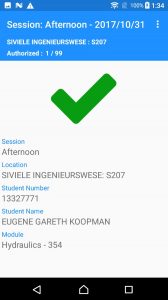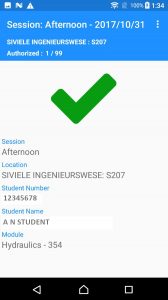[:en]
Until recently granting access to examinations for students has been a manual and time-consuming process of checking-off access lists. However, thanks to new technology developed by Information Technology in collaboration with the Examination Office in the Registrar’s Division, this is no longer the case.
Since June this year, the identification of students for access to examination venues has been facilitated with the use of cell phones at each venue.
A student’s student card is held against the back of the cell phone, and on the screen, it is indicated whether the student is supposed to write the examination in the specific module in the specific venue. The screen will display a green mark if the student is at the correct exam venue (see image right) and a red cross if not. If the student is at the wrong venue, the screen will indicate where the student should be for the exam or test.
This will result in access to examination venues being easily and swiftly controlled and will certainly simplify and improve the function of access control with regard to examination venues.
This easier scanning process is made possible by the NFC (near-field communications) chip on Android phones which communicates with the MIFARE chip embedded in the student card, and the identification information is then used by the phone app to look up the student’s exam venue. The exam venue and module information come from the Student Information System.
Tests were first conducted on a small scale during the November 2017 examination and the technology was rolled out fully for the June 2018 examination. It was a resounding success.
Emce Louw, Head of the Exam Office experienced the impact first-hand as the process was driven from her office. This included loading the cell phones, setting up data, training the convenors responsible for scanning at the venues and collecting the phones after the exams. She received overwhelmingly positive feedback from invigilators and students alike:
“Scan van studentekaarte is fantasties! Ek het gister 4de jaar Megatronika studente gehad. Hulle was vreeslik beïndruk met die scanning!”
The development and successful completion of the technology was a cross-functional team effort. Hendrik le Roux from Information Technology’s Access Control Division was the project manager and Guzelle Hendricks was responsible for business analysis for the two three-month phases of the project which ran from the end of 2017 to June 2018.
In addition to Hendrik and Guzelle the following staff played a key role in getting the project off the ground – Phillip Greeff (TAS), Gregory Isaacs (TAS), Anna-Mari du Toit, Marc-Allen Johnson, Jeremy van Rooyen, Charles Hopkins, who wrote the app and Elmar Matthee who was responsible for the back-end development. On the side of the functional stakeholders, besides for Emce, Neels Fourie (Deputy Registrar), and Jan du Toit and Helene Nieuwoudt (both from SISS) participated in the project.
[:af]
 Tot onlangs was toegang tot eksamenlokale vir studente `n tydrowende handaksie wat uitvoer is deur inligting op toegangslyste na te gaan en af te merk. Nuwe tegnologie, ontwikkel deur Informasietegnologie, in samewerking met die Eksamenkantoor in die Registrateursafdeling, het dit egter verander.
Tot onlangs was toegang tot eksamenlokale vir studente `n tydrowende handaksie wat uitvoer is deur inligting op toegangslyste na te gaan en af te merk. Nuwe tegnologie, ontwikkel deur Informasietegnologie, in samewerking met die Eksamenkantoor in die Registrateursafdeling, het dit egter verander.
Die nuwe ontwikkeling gebruik selfone by elke eksamenlokaal om te identifiseer of studente toegang behoort te kry. `n Student se studentekaart word teen die agterkant van die foon gehou, waarna daar op die skerm vertoon word of die student veronderstel is om die eksamen van die spesifieke module in die spesifieke lokaal moet skryf. Die skerm sal `n groen regmerk wys as die student by die regte eksamenlokaal is (sien grafika regs) en `n rooi kruis wanneer hy/sy nie is nie. Indien die student by die verkeerde lokaal is, sal die skerm ook aandui waar die student wel moet wees vir die eksamen.
Te danke aan dié nuwe proses sal toegang tot eksamenlokale makliker en vinniger hanteer word. Die makliker skanderingsproses is moontlik as gevolg van die NFC (near-field communications) skyfie op Android-fone wat kommunikeer met die ingeboude MIFARE-skyfie in die studentekaart. Die identifikasie-inligting word dan deur die foontoepassing gebruik om die student se eksamenlokaal op te soek. Die eksamenlokaal en module-informasie word onttrek vanaf die Studente Inligtingstelsel.
Toetse is eers op `n klein skaal verlede jaar gedurende die November eksamen uitgevoer en die tegnologie is vir die eerste keer volledig implementeer gedurende die Junie eksamen die jaar. Dit was `n reuse sukses.
Emce Louw, Hoof van die Eksamenkantoor, het die impak van die nuwe tegnologie eerstehands beleef. Sy was betrokke by die laai van die selfone, data-opstelling, oplei van die konvenors wat die skandeerwerk by die lokale moes doen en was ook verantwoordelik vir die insameling van die fone na afloop van die eksamens. Terugvoer vanaf studente en toesighouers was ewe positief:
“Scan van studentekaarte is fantasties! Ek het gister 4de jaar Megatronika studente gehad. Hulle was vreeslik beïndruk met die scanning!”
Die ontwikkeling en suksesvolle voltooiing van die tegnologie was `n poging oor verskeie spanne met verskeie funksies heen. Hendrik le Roux van Informasietegnologie se Toegangsbeheerafdeling was die projekbestuurder en Guzelle Hendricks was verantwoordelik vir die besigheidanalise van die twee driemaande fases van die projek wat gestrek het van einsw 2017 tot Junie 2018.
Bo en behalwe Hendrik en Guzelle het die volgende personeel elkeen `n belangrike rol gespeel – Phillip Greeff (TAS), Gregory Isaacs (TAS), Anna-Mari du Toit, Marc-Allen Johnson, Jeremy van Rooyen, Charles Hopkins, wat die toepassing geskryf het, en Elmar Matthee, wat verantwoordelik was vir bedienerontwikkeling. Aan die kant van die funksionele aandeelhouers het, buiten Emce, Neels Fourie (Adjunk-Registrateur), sowel as Jan du Toit en Helene Nieuwoudt (beide van SISO) aan die projek deelgeneem.
[:]



